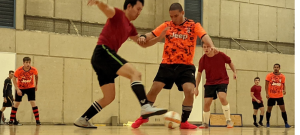Futsal started in 1930 when Juan Carlos Ceriani, a teacher in Montevideo, Uruguay, created an indoor version of Association Football for YMCAs. The development of the game was also influenced by street Football games in Uruguay, Brazil and elsewhere in South America.

The name “Futsal” is believed to have been given to the game some time later when it spread to Brazil. It is a combination of “Futbol” (football) and “Sala” (room).
Numerous small-team football games have developed over the years in other parts of the world, but Futsal is recognised as the preferred version for both development and competition.
People often refer to Futsal by various other names, depending on where they come from. You’ll often hear British players calling it “Five-a-Side Football” or simply “Five-a-Side”. This of course is understandable as there are five on the court for a Futsal game. However it should be noted that it differs from the game usually played in the UK known as “Five-a-side”. Likewise many Australians and North Americans call it “Indoor Soccer” which is the name of another local Football variant.
There are a number of significant differences between Futsal and the British game known as “5-a-Side”.
One major difference is the use of a perimeter fence or net in 5-a-side to keep the ball in play. Futsal players must use their skills to keep the ball in play, the same as in 11-a-side Football.
Also 5-a-side has no real agreed-upon rules, with different leagues having broad variations, including the type of ball, size of the court/pitch and size of the goals. There are some rule variations from one organisation to another, but there are basic principles that are consistent across all leagues: weighted ball, 3m x 2m goal, and minimum court size for community level games (from 25m long) and international/professional standard (38-42m long)
Again, there are big differences between Futsal and the game known in Australia and New Zealand as “Indoor Soccer”. This usually means the game played in commercially run “shed” sports centres (many of which began as Indoor Cricket centres). It usually has a lot in common with 5-a-side; however with Indoor Soccer, team size varies from one competition to another; there may be five, six or seven to a team.
Like Five-a-side, Indoor Soccer uses nets around the boundary of the court, and the ball remains in play as it bounces off these.
An important thing to know about this great sport is that it’s for everyone; professionals playing in European Futsal leagues, young stars honing their skills for outdoor Football, little kids learning lifetime skills; and social players looking for fun, fitness and competition.
For that last category, in Brisbane, come and see Scoreline Sports. Check out our Futsal page, to find out more about joining one of our Social comps.